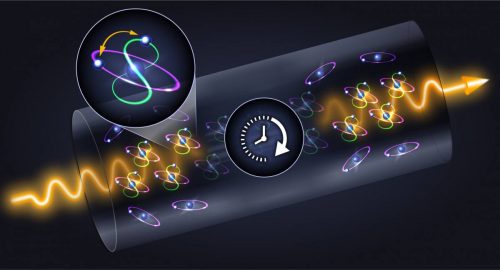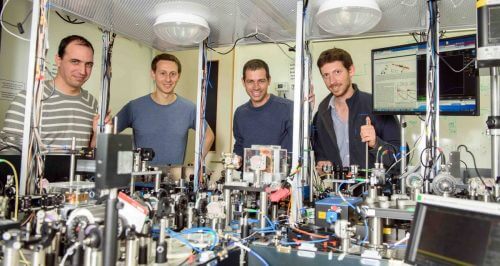A new method of capturing single photons may be a step on the way to quantum memory

How do you stop the light in its movement and hold it - even for a fraction of a second? This ability may be essential for future quantum optical systems, such as secure communication and new types of information technology. A research group led by Dr Ofer Furstenberg At the Weizmann Institute, she recently presented a method in which individual light particles - photons - are captured and released on demand in a way that may be used in the future as a memory for quantum information.
"Photons can carry information just like electrons," explains Dr. Furstenberg, from the Department of Physics of Complex Systems. "In addition, they can travel long distances, such as with optical fibers, without losing information." Because of this, photon-based systems may be better than electronic systems for future communication and remote sensing technologies. Similar to electronic systems, photonic systems need to package and synchronize several units of information. To create such "information packets", control over the timing of the emission of photons is required. Existing devices - light sources - are capable of firing single photons, but do so randomly; There is no way to predict exactly when the photon will be emitted or how long it will be until the next release occurs. One of the ways to deal with this lack of control is to find a method to capture the photons and release them on demand - that is, to store light particles temporarily.
Although Dr. Furstenberg and his research group are not the first to store photons, they are the first to do so in a way that works at room temperature and is also relatively fast, very efficient and noise-free (that is, without information distortion). They call their system "FLAME" (Fast Ladder Memory), and it consists of laser sources and a small amount of pure atomic gas - in this case, of the element rubidium. The electrons of the rubidium atoms act as "photonic memory", and strong laser pulses are used for the writing and reading processes. The flying photons are first stored in excited electrons - whose orbit around the nucleus moves one level out. After a few tens of nanoseconds - a time long enough to synchronize the output from many fast photon sources - the memory is read, and the electrons return to their basic state and the photons to their fast movement.
"This is not a delicate system that only works in high vacuum or at very low temperatures. Eventually, we will be able to put such a system into something the size of a cell phone."
The scientists explain that since what goes in is also what comes out, "Flame" is considered an almost completely noise-free system - that is, without unwanted disturbances that are common in such systems. "The photons released from the electrons are the same as the ones we put in - with exactly the same characteristics and direction of movement. So only about one in 10,000 might be a photon that we didn't put in. As a quantum memory, this is a great system," says student Ran Finkelstein, who led the research in Dr. Furstenberg's lab, alongside Dr. Elon Foam. These findingswere published recently in the scientific journal Science Advances At the same time as the results of similar experiments conducted at the University of Oxford in Great Britain.

The experimental system currently occupies a large table - covered mostly with lasers, mirrors and lenses, but the actual capture takes place in a container the size of a thumb. Ultimately, the scientists hope to minimize the process: an atomic gas containing billions of atoms can be trapped in an airtight space of one cubic millimeter, and since the atoms return to their original state, it can be reused almost without limit. "Actually, we only need three components - a photon source, a trapped gas cloud and a powerful laser," says Finkelstein. "This is not a delicate system that only works in very high vacuum or at very low temperatures. In the end, we will be able to put such a system into something the size of a cell phone."
In the more distant future, the idea of using photons to transfer information in processes such as quantum computing, communication or sensing may also take advantage of one of the stranger aspects of quantum physics - a phenomenon known as quantum entanglement. When two particles are intertwined, the particles cannot be described as separate systems, and their description is only possible as one system distributed over several places. "If the trapped photons were previously entwined with other photons at some distance, this would be quantum communication in the true sense of the word - being based on principles of quantum mechanics that are not seen in the everyday world," says Dr. Foam. Quantum communication, if it can be developed, will be almost impossible to disrupt, so the researchers believe that it will be especially useful for new ways of encryption.
Dr. Furstenberg and his research group plan to test entangled photons in the "flame" array, and they also have additional ideas for new experiments in their quantum-optical system. For example, they intend to create more complex components, such as logic gates for the information carried in the stored photons.
"Although we still do not know which quantum information systems will receive the premiere," says Dr. Furstenberg, "there are some things we know for which photons are the most suitable. For example, the recent discovery of gravitational waves in a distant galaxy relied on powerful optical sensors. Also, our communication messages are already sent today using light waves through thin optical fibers; Photonic 'quantum bits' can travel in similar fibers. Therefore, quantum memory systems based on single photons may have applications in the foreseeable future." True quantum information processing with photons will probably only be possible in the more distant future, but the current research brings that future closer.
See more on the subject on the science website:

6 תגובות
Lorem Ipsum
What you describe is exactly a laser. Apparently this is a much more accurate process than a normal laser, although it is not described.
Conan, in the photoelectric effect, an electric current is created as a result of the light falling on the metal - the electron is ejected from the atom as a result of the photon's impact. Here not only does the electron "just" rise to one higher level as a result of the photon, but when it descends and a photon is emitted, it is emitted in exactly the direction and timing they need.
Yigal
That's not what the article says.
It says "pure atomic gas". That is, a gas made of atoms (oxygen, hydrogen, etc. are not gases of atoms, but of molecules). This gas contains only one type of atom. And the type of atom in this case - rubidium.
Distinguished colleagues,
After all, what is described here is the photoelectric effect and nothing else, and for this Mr. Albert Einstein has already received a Nobel Prize!
am I wrong? And if so - what is the innovation in this publication, in which photons are absorbed by electrons in the atom, which causes the excitation of these electrons and after some time the emission of an amount of energy identical to that which was absorbed - due to the quantization of the atomic energy levels of the electrons in the atom?!? And why do you need "strong laser pulses" for that? I mean, what's wrong with normal or miniaturized lasers? And by the way, the LEGO that confirmed the existence of gravitational waves (which were also born in Albert Einstein's kitchen) is not related at all to capturing photons and exciting electrons in a thin atomic gas!!! And finally - the mention of the "quantum entanglement" effect always sounds great, although there is no explanation here as to how only the entangled photons can be captured!!!
Friend, what is pure rubidium gas?? (What is impure?)
How can it be that with a small push of a button you can make things move at the speed of light? (photons) Isn't there some kind of violation of the laws of physics known to us?